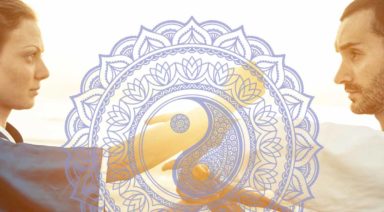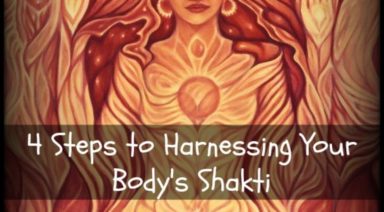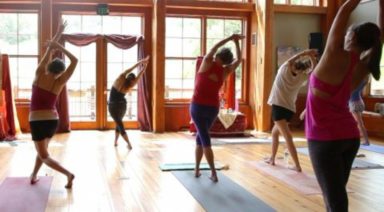Exploring Santosha

Watching for Boredom Within Contentment
Humans have a love affair with drama. The action, suspense, fall from grace, and the phoenix rising again from the ashes. Even in the surprisingly few times life is not delivering us the drama of one fire to tend and another to put out, we go looking for a spark. And then we blow. Why? Because the adrenaline fire of drama is exciting and oh so familiar. No fire feels boring, so the subconscious returns to what is known, even if it is agonizing, in order to feel alive.
The Yoga Sutras encourage the practice of santosha or ‘contentment with oneself and others.’ Far from boring, this practice requires a totally different kind of engagement with the unfolding drama of life than our typical role as flame fanner or fire extinguisher. Maybe those yogis knew how can we feel challenged and alive without burning down the house. Maybe can we cultivate a state of equanimity without it feeling boring.
Webster’s dictionary defines boredom as “the state of being weary and restless from a lack of interest.” Just try to practice santosha or contentment with a lack of interest! Notice first the impulse to ‘do’ but resist the urge to move into dramatic action. Next, observe the tendency to ‘analyze’ but surrender what has been as a good rehearsal. Finally, attempt to be completely absorbed in the action of the fire in front of you – its variety, intensity, and vibrancy – without reaching into the flame.
A different kind of internal spark alights when we practice contentment. Whereas boredom is passive, santosha is unequivocally active. Patanjali’s injunction to be content with oneself and others begins to loosen our overbearing direction of life’s drama. Rather than follow the compulsion to act at every turn – fixing, helping, analyzing, changing, improving, eliminating – we can watch until these urges subside.
Of course we must guard the danger of a swinging pendulum, from one extreme to the other, being neither frenetic fire dancer nor comatose marshmallow roaster. The still point in the middle is where we balance sensory desires and distractions with attentiveness and nonattachment . The lifetime quest of the true Yogi is the effortless embracing of equanimity and receptivity to the Divine moving into manifestation in ever-new form.
Liberation comes when we ‘no longer feel the need to act’ according to Nischala Joy Devi’s translation of Sutra 11.27 in The Secret Power of Yoga. Then, she writes, our constant companions are joy, faith, and clarity. A truly exciting and creative project usually requires that we embrace an uncertain ending. If we refuse to blow on the spark of drama, no matter how familiar the fire feels, we allow santosha to show us the way to peace. In this way we befriend the unknown and watch the magic of our story unfold.
This article is part of an ongoing series on the yamas and niyamas. For the full 10-part series click on each link below:
What is Ahimsa and How to Practice It in Everyday Life

Whether you’re experienced in yoga or just starting out, integrating the practice of ahimsa in everyday life can lead to wonderful strides. Ahimsa is one of the five yamas, which are the ethical, moral and societal guidelines for yogis. Ahimsa can be distilled into a practice of non-violence in all aspects of life, from the physical to the mental and emotional.
Non-violence is defined by honest compassion and true love. You can achieve this by embracing love: learn to love deeply, and also to be loved. However, this is impossible to do if you choose to ignore or escape from certain traits held in yourself.
How Does Non-Violence Manifest in Daily Life?
To understand how non-violence can manifest in our lives each day, we must first learn how subtle daily actions and responses contain elements of violence. This often happens against ourselves. When our thoughts contain negative responses like disappointment, resentment, or guilt, when we feel shame, we are subtly creating violence. If you can’t forgive someone for something they’ve done against you, or if you can’t forgive yourself for something you’ve done, this is an act of violence because it pushes love away.
Expecting too much of yourself and putting all responsibility in your own hands is a type of violence too, as is expecting that the world will run according to your design. You’re being violent towards yourself and the world at large with these kinds of mindsets. Acting out of our fears is a form of violence to the self. We inflict violence on others daily in subtle ways, but this is simply an outward expression of the war that goes on inside of everyone. For instance, when we resent others, it creates a negative atmosphere. Finding inner peace through ahimsa will in turn allow us to come to peace in interactions with others. This may come as a surprise if you consider yourself a non-violent person. Consider how violence can function in the subtlest of ways. Violence disguises itself well; it manifests in words, actions and even inner thoughts.
Instead, embrace and act from your inner truth. Truth and non-violence are a pair.
Yoga is a great way to access ahimsa in our daily interactions. By practicing yoga daily, you can confront your own inner darkness impartially and with compassion. This then paves the way for transforming negative emotions and tendencies without acting on these feelings.
Yoga creates the avenue to getting in touch with any violence you hold inside of you through non-violent means and therefore to express negativity without hurting anyone, yourself included. Releasing negative energy through positive intentions transcends the negative aspects of yourself, creating peace in the world around you.
How to Incorporate Ahimsa
You can incorporate ahimsa into daily activities. For example, some yogis don’t eat meat. But whatever you decide to do with your diet, you should focus on practicing self love in all that you do.
Another way to bring ahimsa into your life is through compassion. It’s the ability to accept events as they are with an open heart, letting go of reacting in any negative way and replacing those feelings with kindness and acceptance.
Also, move with intention. Consciously put non-violence into action. Instead of letting the limits of your body create stress, make the decision to intentionally respect and even love the limitations your own body has. Perform yoga poses gracefully, but do it without force.
Yoga gives you the chance to practice non-violence in your mind at the same time. While tuning in to your body, simultaneously start to watch as your thoughts form. Cultivate your awareness of your own thoughts to find if there are hints of violence against yourself or others in your life. Awareness doesn’t mean reaction, though. You don’t need to push these thoughts away ” just recognize them. Observe as they come into your consciousness, and then watch as they again leave.
Ahimsa in the Body and Mind
We can understand ahimsa as the being mindful of thoughts. Thoughts naturally move into and out of our minds. The thoughts themselves don’t necessarily cause harm. However, holding onto thoughts and letting them repeat again and again in your mind is what in the end turns into actions or words of violence. Start to practice simply observing your thoughts instead of reacting to them. When you allow yourself to acknowledge and observe, you’ll find that your thoughts slip from your awareness just as easily as they come in.
You can be at the peak of health and still have your thoughts deeply affect your wellbeing. Yes, exercising and eating well are hugely important for your health, but even if you do these things “right,” your thoughts can harm you. Negative thinking sends out messages to the body that trigger the fight or flight response. Thoughts do this even if there’s no outside threat.
The fight or flight response secretes cortisol, which you might know better as the stress hormone. This, in turn, lowers the immune system, and that then makes us more likely to experience physical pain and sickness. And again, it’s not just those pesky bad thoughts we have about ourselves that do this. Jealousy, anger and judgement toward others make us feel bad as well.
That’s where our non-violent thoughts come in. When we think lovingly, these thoughts trigger dopamine’s release into the body. Dopamine is that chemical that makes you feel good and relax. Unlike cortisol, dopamine brings strength to the immune system. It can even cure illness. Those who think of themselves as optimists tend to have stronger immune systems and recover faster from illnesses and injuries. Optimists may even live longer than those who think of themselves as pessimists.
What This Means for You
When you turn your yoga practice into a complete lifestyle, ahimsa can guide your daily interactions with yourself and others. Anyone, regardless of experience, can get frustrated when the physical components of yoga don’t move forward as quickly as planned. Keeping ahimsa in mind as we practice yoga lets us move out of negative thoughts about the body. We can then accept ourselves totally, no matter how flexible, how strong we may be in any given moment.
This translates to all aspects of our lives. In the physical sense, non-violence means not pushing yourself over the edge. You can, of course, still challenge yourself so that you can grow; in fact, you must. But embracing ahimsa means not pushing yourself to harm.
You shouldn’t put much stock in holding a handstand long enough to please your ego if it brings you harm. Likewise, you shouldn’t hold on to resentment or jealousy against yourself or someone else. Embracing ahimsa instead will improve your own well-being as well as those around you.
Everyone holds pain inside themselves, but you can overcome this in a positive way when you practice ahimsa. There is nothing inherently wrong with this; it’s human nature. We must, however, learn to fully experience these negative feeling without reacting negatively to them. This may seem contradictory, but ahimsa leads to a path of peaceful living. By observing but not acting on our natural feelings of pain, hatred, pain and violence will move out of our lives, and doors will open to new understanding.
Let go of expectations of what you should do. Stop clinging to the need to scold yourself with negative, violent thoughts. When we do this, our bodies respond. Instead of bringing in those negative emotions and working against us, our bodies start working with us.
Practice ahimsa in your interactions each day by accepting, then releasing negative thoughts about yourself and others. If you’re looking for other ways to bring ahimsa into your everyday practices, you can find them here on Gaia. You can have ahimsa in your diet, in your thoughts, and in how you communicate with the people around you.
The yoga practice of non-violence can easily move into all aspects of your life. Yoga creates a peaceful reconciliation with your true nature. Non-violence comes from love of the true self, from true self-acceptance. This ahimsa comes from deep in the heart.





































